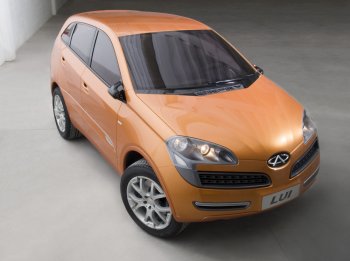|
Only formed
earlier this year, Italy's newest design house, Torino
Design, in following in a long standing Turinese tradition,
and they recently presented results of their first project:
Lui and Lei - two concept cars specially created for Chinese
carmaker Chery. The Torino Design company was created back
in March by Roberto Piatti and Giuliano Biasio, two former
directors of Stile Bertone, with a brief to work in the
areas of automotive and industrial design. Lui and Lei are expressions of new horizons in terms of
styling for Chery, marked by strong cuts to define
volumes and a clever use of complex surfaces.
Chery Lui ("He" in English) is a sporty, dynamic SUV that
fully embodies the concepts of compactness, movement and
strength. Its imposing, aggressive volume is lightened optically
by heavily sculptured surfaces that link up the various
parts of the body. The side has a robust "shoulder" stretching along the
waist-line right up to the front wing and then veering
upwards to become the feature providing a link to the
bonnet. The clean cut of the shoulder that underscores
the glass surfaces and sculpting on the wings together
with the cut of the tail thrust the volume forward to
create considerable dynamism when viewed from the side.
The front-end heavily emphasises the impression of size
and is surrounded by a complex C-shaped element that
integrates the large light units and air-intakes with a
floating graphic effect. The prominent feature of the
centre is the large Chery
logo, which again has a floating effect, in an oval
air-intake which is also the starting point for the
diverging grooves on the bonnet. The mirrors are an innovative feature in terms of
industrial design as they are the result of a technical
study aimed at making them more functional. A device has
been added to the front of this component that can
project a beam of light, while there is also a small
camera mounted on the back.
The second concept is called Lei ("She" in English)
and is a youthful, sporty, compact coupé. The aim of the design was to express a strong idea of
innovation and a break with more classical styling cues
thanks to a new way of interpreting complex surfaces
together with clean-cut lines that give it a unique
personality. The front view has been designed around the
Chery logo,
which also marks the starting point for the lines that
surround the lights, the folds in the bonnet and the large wings.
|
 |
|
The high, muscular rear-end
of Chery Lei underlines the concepts of
strength and power right where the faceted surfaces surround
the rear light units. |
|
 |
|
|
 |
|
Chery Lui is a sporty, dynamic SUV that
fully embodies the concepts of compactness, movement and strength. Its imposing, aggressive volume is lightened optically
by heavily sculptured surfaces that link up the various
parts of the body. |
|
 |
|
 |
|
The side of the Chery Lui has a robust "shoulder"
stretching along the waist-line right up to the
front wing and then veering upwards to become the
feature providing a link to the bonnet. |
|
 |
|
|
The cut of the seat for the butterfly windscreen wiper is
the element that gives the bonnet a highly original upper
profile. Starting from the front-end the side is marked by a surface
sloping along the waist-line running up to a very graphic
cut at the tail-end. The side glass surface link up to the windscreen and rear
window; optically the uprights seem to join to the lower
body without touching it, creating a new floating dome
effect that highlights the volume giving it a new sporting
dynamism.
The high, muscular rear-end underlines the concepts of
strength and power right where the faceted surfaces surround
the rear light units. For the very first time functional features become elements
of style: the logo itself is the starting point for all
lines of the design while the mirrors cut through the air.
|
|
|
|